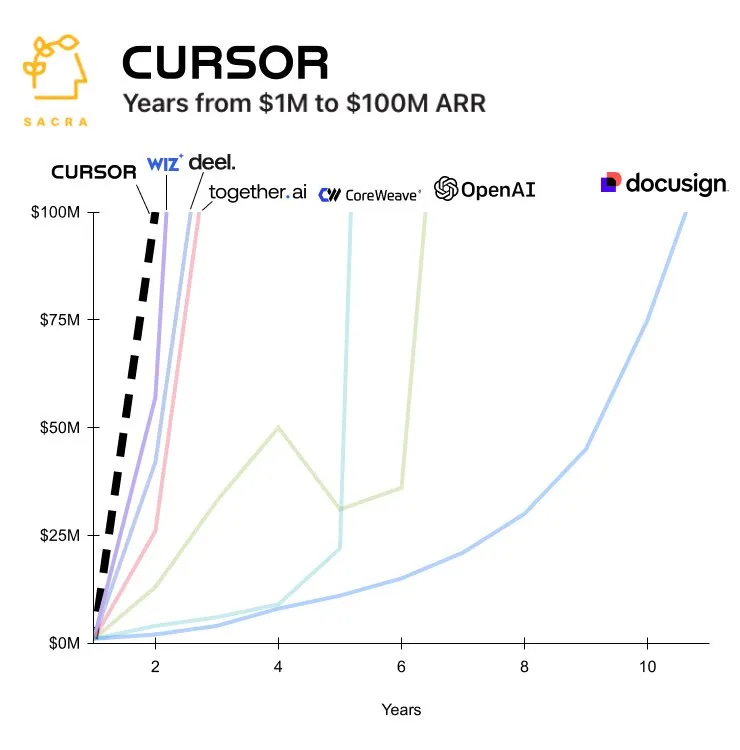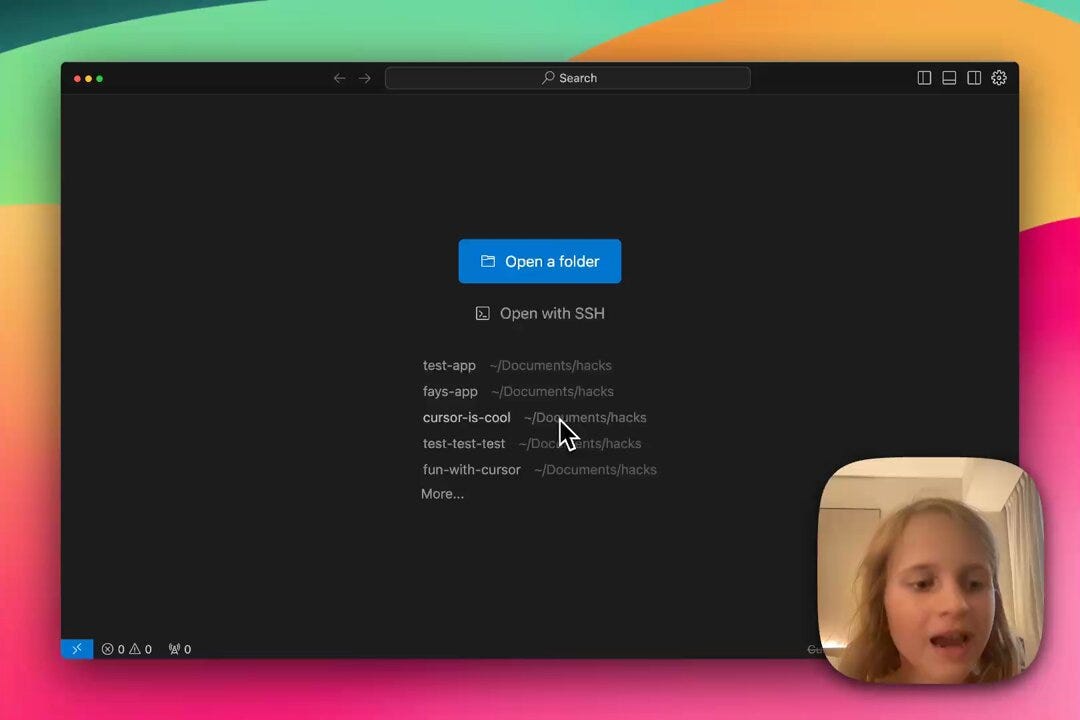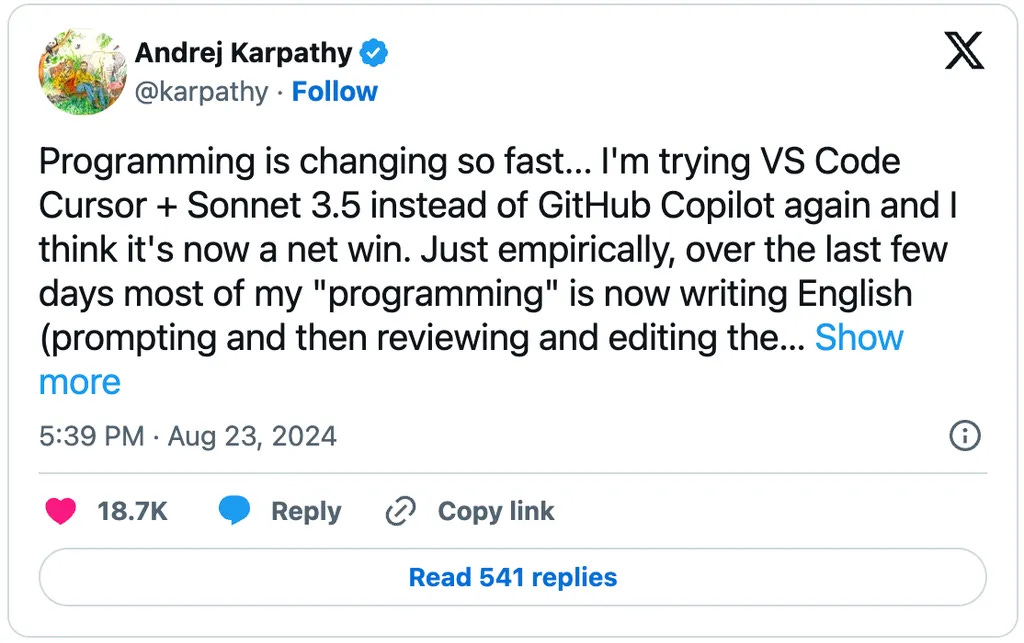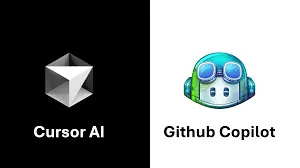In 2022, four MIT graduates started Cursor right out of university – an editor where developers could generate 2,000-line pull requests from just 50 lines of pseudo code, eliminate bugs entirely, and get instant answers to any codebase question. Within two years, Cursor rocketed from $1M to $100M ARR, eclipsing GitHub Copilot’s growth. But what made this underdog story possible?
According to Sacra, Cursor skyrocketed from $1M in ARR in 2023 to $100M by the end of 2024—a staggering 9,900% year-over-year growth. It reached this milestone in just 12 months, surpassing other high-growth companies like:
Wiz (18 months to $100M ARR)
Deel (20 months to $100M ARR)
Ramp (24 months to $100M ARR)
The hype around Cursor AI has been real. To give an example, Ricky Robinett, VP of developer relations at Cloudflare, posted a video of his eight-year-old daughter building a chatbot on the Cloudflare Developer Platform in just 45 minutes using Cursor AI, documenting the whole process, even the spelling mistakes while giving prompts! In this edition of Product Curious, we look into Cursor’s distribution hacks, Product Led Growth tactics, and an insane focus on Developer Community growth.
The Secret Sauce: 3 Product Principles That Made Cursor Unstoppable
When people think ‘AI plus coding,’ their mind usually goes to AI-powered autocomplete. Cursor AI thinks this has been done particularly well by GitHub Copilot and others, so they focused on problems that come after autocomplete, like finding and fixing bugs and codebase Q&A.
1. Performant, Aware and Flexible: AI-Native First, Editor Second
The team rejected the prevailing "AI as plugin" paradigm, instead rearchitecting the entire coding environment around AI capabilities from the ground up. They also knew that developers would abandon a tool that slowed them down, so Cursor was always designed for speed. This manifested in three foundational choices:
Forked VS Code Architecture: By modifying VS Code's core rather than building plugins, they gained low-level access to implement features like real-time model inference (achieving <150ms latency vs. GitHub Copilot's 300-500ms).
Contextual Awareness Engine: Unlike tools limited to single-file analysis, Cursor indexes entire codebases to power features like cross-file refactoring and architecture suggestions.
Multi-Model Orchestration: Early integration of OpenAI, Anthropic, and proprietary models allowed performance optimization per task (e.g., Claude for creative solutions, GPT-4 Turbo for boilerplate)
2. Massive Developer Empathy: Reducing Cognitive Load
Cursor’s UX decisions stemmed from obsessive study of developer workflows:
Frictionless Adoption: Maintaining VS Code keybindings and UI conventions reduced switching costs, helping capture 360,000+ developers in just about 18 months
Cognitive Load Reduction: Features like "Codebase Chat" (natural language Q&A about project structure) and auto-generated documentation directly address pain points identified in 200+ user interviews,
3. Code Privacy. That’s Cursor!
Local Processing: All code analysis runs on-device unless explicitly opted into cloud processing.
Selective Context Sharing: Users control which code snippets are sent to AI models, with automatic scrubbing of sensitive patterns (API keys, credentials)
From Zero to Viral Hero: The Growth Explosion Recipe
Cursor’s first 1000 users came through targeted outreach to MIT alumni and Y Combinator’s startup network in late 2022. The team implemented three growth hacks:
Freemium Led Growth:
Cursor’s pricing model created a self-reinforcing adoption loop. The free tier’s 2,000 completions aligned with average hobbyist usage patterns, while paid tiers targeted professional needs. This structure achieved:
14% free-to-paid conversion rate
40% team adoption within 30 days of individual upgrade
Product Led Growth:
VS-Code Familiarity: By maintaining VS Code keybindings and UI conventions, they reduced the learning curve for developers already comfortable with VSCode.
Smartly Hiding Latency: Prefetching suggestions during natural pauses (file saves, keystroke gaps) created perceived instantaneity
Vertical Integrations: Partnerships with Vercel/Replit enabled one-click deployments from editor reducing context switching dramatically.
Community Led Growth: Early adoption by engineers at influential companies like OpenAI, Midjourney, and Perplexity created word-of-mouth buzz within the developer community. However, a lot of success is attributed to three key masterstrokes:
Open Source Contributions: Founders contributed to React/TensorFlow with Cursor-optimized code, attracting maintainers.
"Edited with Cursor" Footers: Auto-added to pull requests, driving 32% of organic signups via GitHub visibility.
Coding Bootcamp Partnerships: Free licenses for Lambda School/Fullstack Academy created bottom-up enterprise adoption (22% conversion to paid within 6 months)
Why Cursor Has a Strong Future Against Incumbents
Despite being a newer player, Cursor has built impressive advantages that position it well against tech giants like Microsoft and GitHub. Here's what makes Cursor special:
Lightning-Fast Performance
Instant Response Times: Thanks to clever engineering, Cursor responds twice as fast as GitHub Copilot (sub 150ms latency) making coding feel smooth and natural
Smarter Code Understanding: Unlike other tools that only look at one file, Cursor understands your entire codebase, making it better at suggesting improvements and fixes
Best-in-Class AI: By combining multiple AI models (GPT-4, Claude 3.5, and others), Cursor picks the perfect tool for each task - whether you're writing new code or fixing bugs
Privacy You Can Trust
Your Code Stays Private: Cursor processes your code locally on your computer, not in the cloud (unless you specifically opt for it)
Enterprise-Ready: Cursor earned important security certifications (SOC2 Compliance) in record time, making it safe for business use even in highly regulated industries.
You're in Control: You decide what code snippets Cursor can see, and sensitive information is automatically scrubbed.
Growing Ecosystem
Cursor works seamlessly with popular developer tools building an ecosystem through strategic partnerships:
Built By Developers, For Developers
Cursor puts the developer community first, operationalizing developer communities as a defensible asset and building strong brand loyalty.
Additionally, Cursor achieved $276 ARPU through individual developers, avoiding enterprise sales complexity.
The Future of AI Coding: Why You Should Be Excited About It?
Cursor published its initial roadmap in 2023 titled "Our Problems" and a follow-up in 2024 titled "More Problems," offering unique insights into how a category-defining AI startup prioritizes challenges. For early-stage founders and product managers, this roadmap reveals vital lessons in building defensible AI products, executing community-driven development, and maintaining technical momentum. Here are the three core problems that stand out:
1. Contextual Intelligence at Scale: Teaching AI to Understand Entire Codebases
Cursor aims to transform how AI understands codebases by integrating diverse data sources:
500k Token Context Window: Aggregating open files, git history, execution traces, and external docs into a unified context.
Custom Reranker Model: Filters context to 8k relevant tokens per query while maintaining <150ms latency.
1.4B+ Vectors Indexed: Scaling codebase understanding to enterprise-grade repositories.
Why It Matters: Traditional AI coding tools (GitHub Copilot) operate on single-file contexts, limiting their utility in complex projects. Cursor's approach enables cross-file refactoring and architecture-level suggestions—critical for enterprise adoption.
2. Edit-Centric AI Workflows: Fix More, Type Less
Cursor is reimagining AI's role in code modification:
"Copilot for Edits": Focuses on low-entropy keystroke reduction for existing code (renames, type changes).
Real-Time Diffs: Unobtrusive visualizations of AI-proposed changes during active coding sessions.
Multi-File Refactoring: Agents that modify entire directories while preserving code structure.
Why It Matters: Developers spend 70% of time modifying existing code. Tools optimizing this phase unlock 10x productivity gains vs. new-code-focused solutions.
3. Constrained-Agent Architectures: Smarter Agents, Fewer Mistakes
Cursor is pioneering a new paradigm for AI-assisted development:
Few-Step Agents: Execute tasks like dependency upgrades within defined boundaries, consulting users for feedback.
Local-First Execution: Operates on 100k-token codebases without cloud dependencies.
Passive Bug Detection: Background scanning + active debugging modes.
Prefetching: Anticipates developer needs during natural pauses (keystroke gaps, file saves)
Why It Matters: Autonomous coding agents often produce unstable results. Cursor's constrained approach balances automation with human oversight—a model for reliable AI products.
In conclusion, Cursor’s journey from MIT dorm room to $100M ARR demonstrates the transformative potential of AI-first tooling. By combining technical audacity (forking VS Code) with community-driven growth, the team has created a new paradigm for developer productivity. As AI capabilities advance, Cursor’s focus on real-time collaboration, local model execution, and richer vertical integrations positions it to define the next era of software development. Emerging startups should heed their playbook: integrate deeply, iterate relentlessly, and empower users as co-creators!












